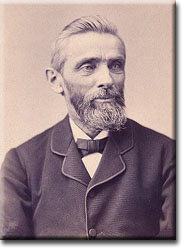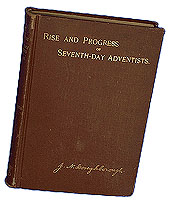John Norton Loughborough
(1832-1924)

J. N. Loughborough accepted the Sabbath at Rochester, New York, in 1852, as a result of the preaching of J. N. Andrews. It was here that he first met James and Ellen White. He and his family had gone through the 1844 disappointment as believers. From the age of 17, Loughborough was a lay preacher for the First-day Adventists.
A month after he was introduced to the Sabbath by J. N. Andrews, he began preaching for the movement that later would become known as the Seventh-day Adventist Church. A vision given to Ellen White helped him to begin, when he doubted whether he could support his family. Relating this vision Ellen White said: "Brother Loughborough is holding back from his duty to preach the message, trying to get means for his support. The Lord told me to say, 'Decide to preach the message and the Lord will open the way for your family's support.'"
--Divine Predictions Fulfilled, pp. 25-27. He had been selling sashlocks, but it had not gone well. Down to his last three cents, he gave his wife a penny for thread and a penny for matches. While she was gone, a man came to the door and ordered $60 worth of sashlocks. Loughborough made a profit of more than thirty dollars on the sale. His ministry was begun.
 Loughborough was the youngest to be ordained to the ministry, being only 22 years old in 1854. After discussing it with James White, he decided to sell complete sets of adventist publications issued by our press at that time--35 cents' worth. It was a success from the beginning. In 1868 he pioneered SDA work in California with D. T. Bourdeau. He spent five years in England, beginning in 1878, and served as president of several conferences after returning to the United States. In 1892 Loughborough published the first Seventh-day Adventist history, The Rise and Progress of Seventh-day Adventists, later revised and expanded as The Great Second Advent Movement. He also published The Church, Its Organization, Order, and Discipline in 1907. This book served for several years as a church manual, until an official manual was adopted in 1932.
Though Loughborough is more often remembered as an administrator and church historian, in his early ministry he was a successful public evangelist, and conducted the first tent meetings. In 1856 he became discouraged and decided to go to Waukon, Iowa, to farm. James and Ellen White went to Waukon by horse and sleigh to persuade him to return. Their winter trip across the plains and the frozen Mississippi River is a story of God's care. The Whites persuaded Loughborough to return to the ministry, and he never wavered again, though times were difficult in the beginning. In 1869 he went to California in company with D. T. Bourdeau as the first "missionary" to that State.
Loughborough was the youngest to be ordained to the ministry, being only 22 years old in 1854. After discussing it with James White, he decided to sell complete sets of adventist publications issued by our press at that time--35 cents' worth. It was a success from the beginning. In 1868 he pioneered SDA work in California with D. T. Bourdeau. He spent five years in England, beginning in 1878, and served as president of several conferences after returning to the United States. In 1892 Loughborough published the first Seventh-day Adventist history, The Rise and Progress of Seventh-day Adventists, later revised and expanded as The Great Second Advent Movement. He also published The Church, Its Organization, Order, and Discipline in 1907. This book served for several years as a church manual, until an official manual was adopted in 1932.
Though Loughborough is more often remembered as an administrator and church historian, in his early ministry he was a successful public evangelist, and conducted the first tent meetings. In 1856 he became discouraged and decided to go to Waukon, Iowa, to farm. James and Ellen White went to Waukon by horse and sleigh to persuade him to return. Their winter trip across the plains and the frozen Mississippi River is a story of God's care. The Whites persuaded Loughborough to return to the ministry, and he never wavered again, though times were difficult in the beginning. In 1869 he went to California in company with D. T. Bourdeau as the first "missionary" to that State.
Loughborough saw Ellen White in public vision more often than any other person, with the exception of her husband, James. Late in his life he claimed to have witnessed more than 50 public visions. On several occasions, these visions included physical phenomena. He was also present in Rochester, New York, when she prayed for the healing of the pressman, Oswald Stowell. Stowell had been given up by the physician to die. He was healed and back at work in two days.
Loughborough joined James and Ellen White in advocating church organization in 1860. Often they traveled together, in public ministry to the church. He died at age 92, in 1924, after more than a half century of service.